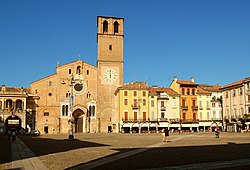Lodi
(Redirected from Lodi, Lombardy)
Lodi | |
|---|---|
| Comune di Lodi | |
 Piazza della Vittoria | |
 | |
| Coordinates: 45°19′N 9°30′E / 45.317°N 9.500°E | |
| Country | Italy |
| Region | Lombardy |
| Province | Lodi (LO) |
| Frazioni | Fontana, Olmo, Riolo, San Grato |
| Government | |
| • Mayor | Sara Casanova[1] (Lega Nord) |
| Area | |
| • Total | 41 km2 (16 sq mi) |
| Elevation | 87 m (285 ft) |
| Population (30 November 2012)[3] | |
| • Total | 43,325 |
| • Density | 1,100/km2 (2,700/sq mi) |
| Demonym | Lodigiani or Laudensi |
| Time zone | UTC+1 (CET) |
| • Summer (DST) | UTC+2 (CEST) |
| Postal code | 26900 |
| Dialing code | 0371 |
| Patron saint | St. Bassianus |
| Saint day | 19 January |
| Website | Official website |
Lodi (Italian: [ˈlɔːdi] (![]() listen); Lombard: Lòd) is a city in northern Italy. Lodi is in the Lombardy Region with a population of 43,488 people (as of 2008).[4] The people who live in Lodi are called Lodigiani. Lodi is famous for a cake called Tortionata.
listen); Lombard: Lòd) is a city in northern Italy. Lodi is in the Lombardy Region with a population of 43,488 people (as of 2008).[4] The people who live in Lodi are called Lodigiani. Lodi is famous for a cake called Tortionata.
Lodi was built after the destruction of the ancient roman city of Laus Pompeia during the war with Milan.
The construction of the new city was aided by the German emperor Frederick I Barbarossa.
Sister Cities[change | change source]
 Constance, Germany
Constance, Germany Lodi, California, United States
Lodi, California, United States Omegna, Italy.
Omegna, Italy. Fontainebleau, France.
Fontainebleau, France.
References[change | change source]
- ↑ "Dipartimento per gli Affari Interni e Territoriali". elezionistorico.interno.gov.it.
- ↑ "Superficie di Comuni Province e Regioni italiane al 9 ottobre 2011". Italian National Institute of Statistics. Retrieved 16 March 2019.
- ↑ Population data from Istat - Italian Institute of Statistics
- ↑ source ISTAT - Italian Institute of Statistics
- Agnelli, Giovanni (1917). Lodi ed il suo territorio nella storia, nella geografia e nell'arte. Lodi.
{{cite book}}: CS1 maint: location missing publisher (link) - Bassi, Agenore (1977). Storia di Lodi. Lodi: Edizioni Lodigraf. ISBN 88-7121-018-2.
- Mario-Giuseppe Genesi, Gli Organi Storici del Lodigiano, Piacenza, L.I.R. Editrice, 2017, pp. 720.





